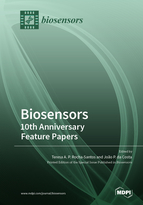Biosensors: 10th Anniversary Feature Papers
A special issue of Biosensors (ISSN 2079-6374).
Deadline for manuscript submissions: closed (15 December 2021) | Viewed by 22295
Special Issue Editors
Interests: plastics; nanoplastics; microplastics
Special Issues, Collections and Topics in MDPI journals
Interests: development of analytical methodologies fit for purpose; (bio)sensors, plastics; microplastics
Special Issues, Collections and Topics in MDPI journals
Special Issue Information
Dear Colleagues,
The Biosensors journal was funded in 2010. During these 10 years, Biosensors has published more than 50 special issues and 550 papers and welcomed breakthrough and innovative papers in biosensors developed for applications in food, health, security and defence, and environmental fields. The Biosensors journal also covers all aspects of sensors incorporating biorecognition elements, such as (but not limited to) enzymes, antibodies, nucleic acids, whole cells, tissues and organelles, and other biological or biologically inspired components. All the transducer principles are also covered in this journal. The year 2020 marks its 10th anniversary and its acceptance for coverage in the Science Citation Expanded (SCIE) in Web of Science. We are thus excited to celebrate the Biosensors journal’s 10th anniversary with a Special issue.
This Special Issue welcomes both research and review papers in the most recent and innovative developments of biosensors for applications in the food, health, security, and defence and environmental fields.
Dr. Teresa A. P. Rocha-Santos
Dr. João P. da Costa
Guest Editors
Manuscript Submission Information
Manuscripts should be submitted online at www.mdpi.com by registering and logging in to this website. Once you are registered, click here to go to the submission form. Manuscripts can be submitted until the deadline. All submissions that pass pre-check are peer-reviewed. Accepted papers will be published continuously in the journal (as soon as accepted) and will be listed together on the special issue website. Research articles, review articles as well as short communications are invited. For planned papers, a title and short abstract (about 100 words) can be sent to the Editorial Office for announcement on this website.
Submitted manuscripts should not have been published previously, nor be under consideration for publication elsewhere (except conference proceedings papers). All manuscripts are thoroughly refereed through a single-blind peer-review process. A guide for authors and other relevant information for submission of manuscripts is available on the Instructions for Authors page. Biosensors is an international peer-reviewed open access monthly journal published by MDPI.
Please visit the Instructions for Authors page before submitting a manuscript. The Article Processing Charge (APC) for publication in this open access journal is 2700 CHF (Swiss Francs). Submitted papers should be well formatted and use good English. Authors may use MDPI's English editing service prior to publication or during author revisions.








